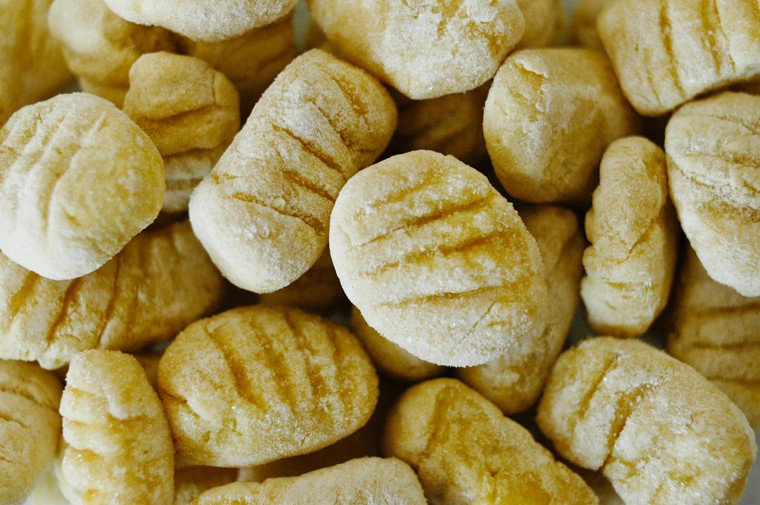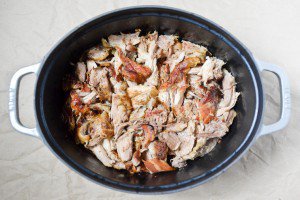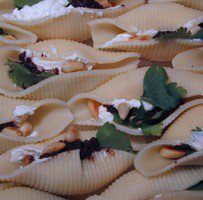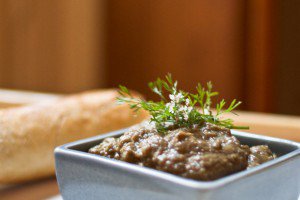I have recently found myself with a bit of a potato glut, a rather unusual state of affairs for me. It being spring, all the potatoes wanted to do was sprout, however careful I was to keep them in a cool, dark place. Unable to temper their enthusiasm, I did what any responsible cook would do: I embraced the potato theme and cooked them in all sorts of different ways over a few weeks.
With the baking potatoes (the floury ones that fall apart when cooked), I made baked potatoes (creative, I know), potato skins (with the leftover baked potatoes), home fries, and Jo Jo potatoes; with the waxy ones (the yellow-fleshed variety that retains its shape when cooked) I made sautéed potatoes in my new/old cast-iron skillet; with a mix of both, I baked a very simple, very good gratin dauphinois that I must make again, photograph, and tell you about.
I also took this potato manna as a sign that it was finally time to try my hand at potato gnocchi, an endeavor I had long itched to undertake: I had made ricotta gnocchi and speculoos gnocchi in the past, but had yet to attempt a potato-based version.
I used the basic proportions given in an article I’d clipped out of the British Olive magazine, and all went smoothly. At first, I feared I had not mashed the potatoes thoroughly enough, but I ignored the tiny lumps and forged ahead, experimenting with different shapes for the pillows of dough (ovals or corks, mostly), and trying to gain a semblance of dexterity through the process.
Most recipes I found have you roll the gnocchi against the tines of a fork to create the signature indentations that will help the sauce cling to them, but I’d read somewhere that you could also use the lower part of a wire whisk — where the wires all gather and throw themselves into the handle — and that method worked much better for me.
Maxence and I ate half of the batch that night — I froze the rest for another day — with white asparagus tips, lemon verbena butter, and a sprinkle of pecorino shavings. I was delighted with the outcome: the gnocchi turned out plump and tender, fluffy on the inside, with a hint of a blond crust from the pan-frying step.
The recipe produces plain potato gnocchi to dress with the sauce of your choice, but you can certainly play around with flavorings, incorporating herbs, dried or fresh, garlic, saffron, truffle juice… Any favorites to share?

Have you tried this? Share your pics on Instagram!
Please tag your pictures with #cnzrecipes. I'll share my favorites!
Ingredients
- 600 grams (1 1/3 pounds) unpeeled baking potatoes (the kind you would use for mashed potatoes; not waxy)
- 1 egg, lightly beaten
- 1 teaspoon fine sea salt
- 200 grams (7 ounces, about 1 2/3 cups) flour
Instructions
- Place the scrubbed but unpeeled potatoes in a pan of cold water, bring to a boil, add a bit of coarse salt, and boil for 20 minutes, or until a knife can be inserted easily through their center.
- Alternatively, as Hannah helpfully suggested in the comments, you can bake the potatoes instead: wrap the potatoes in foil and roast them in a 220° [430°F] oven until tender -- for 45 minutes to 1 hour, depending on their size. The potato flesh will be drier then and will require less added flour to form into a dough, resulting in lighter gnocchi.
- Peel the potatoes while still hot. You can use a folded dishtowel to hold the hot potato; I slice the potato in two, place it cut side down on a cutting board, and peel off the skin from each half with the tip of a knife while barely touching them.
- Mash the peeled potatoes thoroughly in a medium mixing bowl, using a potato masher or ricer (avoid overmashing). Stir in the egg and salt. Add about three quarters of the flour and stir it in. As soon as it is absorbed, turn the dough out on a lightly floured work surface. Knead it quickly until smooth but still a little tacky. If you find it is really too sticky to work with, add a little more of the flour. Avoid overkneading or the gnocchi will be tough.
- Divide the dough in four pieces. Place three of them on a lightly floured plate and in the fridge while you work on the fourth.
- Roll the piece of dough into a log, then continue to roll it with the palms of your hands to form a long sausage, about 2 cm (3/4") in diameter. Add a little more flour on your work surface and on the dough as needed. Using a knife, cut the sausage in short, pillow-like sections, about 2.5 cm (1") in width.
- Using well-floured hands, shape each pillow into a somewhat oval or cork-like shape, and press it against the base of a wire whisk to create indentations. Reserve the dumpling on a lightly floured plate and repeat with the rest of the sections. Place the plate in the fridge, and repeat with the rest of the dough. This can be done a few hours ahead.
- At this point, the gnocchi can be frozen: arrange in a single layer on a baking sheet that fits inside your freezer and freeze for an hour, or until hardened, before transferring to an airtight container. (If you skip the single layer thing, they will clump up into a mass and you'll be sorry.)
- To cook the gnocchi (fresh or still frozen), drop them in a pan of simmering salted water, working in batches if necessary so they're not too crowded. After a few minutes, the gnocchi will rise to the surface (you may have to loosen them slightly if they've stuck to the bottom of the pan); cook for 2 more minutes starting from that moment. Fish them out of the pan with a slotted spoon and reserve in a colander while you poach the remaining batches.
- Reheat and sauté the gnocchi in a skillet in a little olive oil or butter before serving as is, or with the sauce of your choice.
This post was first published in June 2009 and updated in July 2016.















